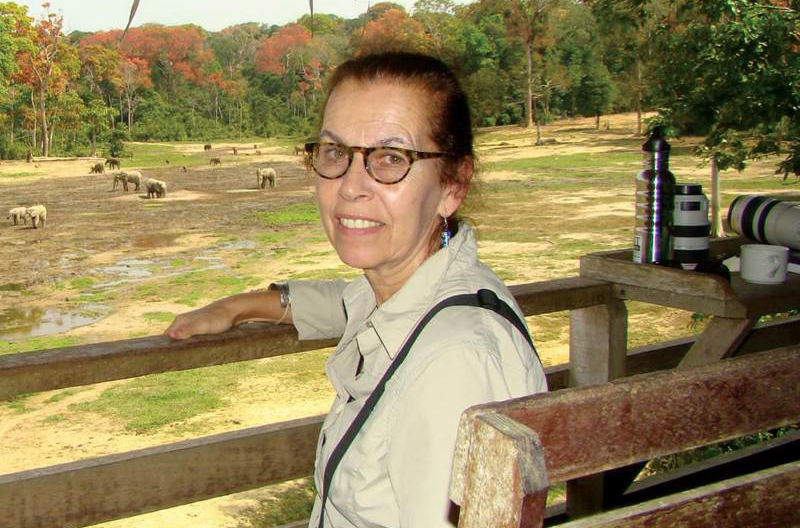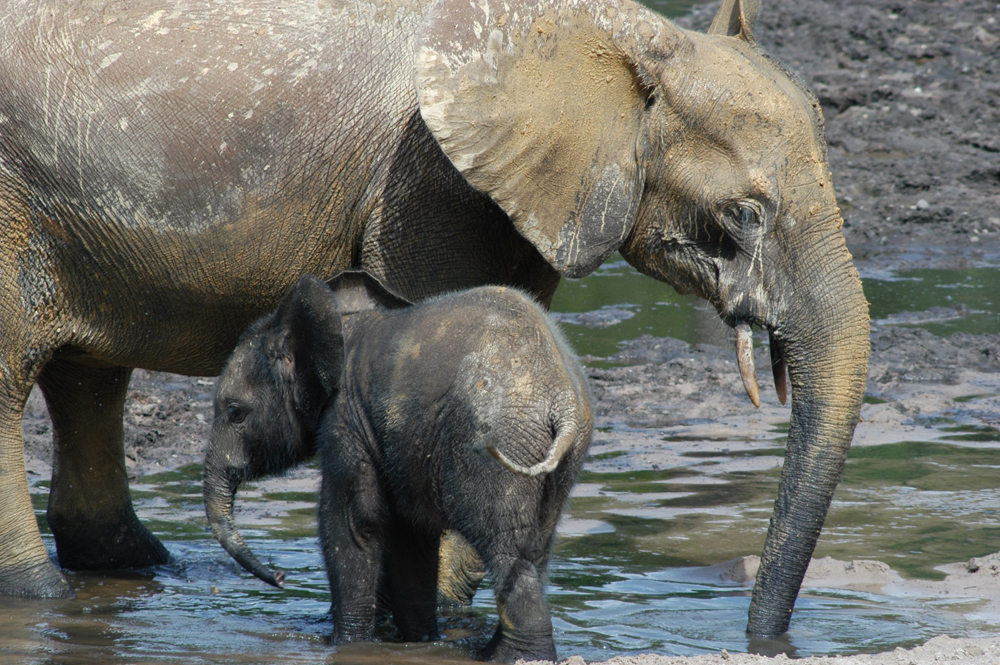Missing For 9 Years, Ahmed The Elephant Returns
Long considered dead, a great mellow bull reappears at Andrea Turkalo’s study site in the Dzanga Bai.
By Vicki Croke
Last seen in 2006, Ahmed simply reappeared recently giving no clue about where he’s been. Photo: Andrea Turkalo/WCS.
Andrea Turkalo, who’s gotten to know some 4,000 forest elephants over the past 20 years, has recently spent months focused on a bit of sad detective work: Through careful observation, she’s been slowly piecing together a list of the dead and of the living.
Each day, as many as 100 elephants materialize in front of her viewing platform in the Dzanga Bai forest clearing in Central African Republic. While the elephants socialize, wrestle, mate, and drink mineral-rich water, the Wildlife Conservation Society researcher figures out which of her study elephants were killed during a 2013 raid by Seleka rebels, and which survived. It is difficult work for someone who considers these animals to be family.
Elephants at the Dzanga Bai can socialize, wrestle, and drink mineral-rich water. Photo: Andrea Turkalo.
But during the process, there’s been a small miracle in a big package: a great old bull, missing since before that slaughter, and long presumed dead, suddenly reappeared as though risen from the grave.
It is the return of Ahmed, most mellow of males, who vanished nine years ago, and who, with no fanfare, came sauntering through the muddy clearing with his powerful gray bulk, long, thin, curved tusks, and serene expression.
“It was a bit emotional,” Turkalo says.
The good news is welcome for Turkalo who was, for the first time ever, forced to flee the outbreak of violence three years ago. And since returning in 2014 to her ransacked camp, she has been tallying up a detailed accounting of the spree in which, she figures, 26 elephants were killed. Because of the elusive nature of forest elephants (now considered a separate species from the bigger savannah elephants) and the impenetrability of the forest where they live, Turkalo pieces the puzzle together bit by bit as elephant families come to the water in front of her viewing platform, where she has spent nearly every day for decades.
To Andrea Turkalo, considered by many to be the world’s top forest elephant expert, the animals can seem like family. Photo: Elizabeth Bennett/WCS.
It is from here that she has just released information about the sad conclusion that two of the best-known matriarchs—Aida I and Phyllis I are most certainly dead. After all, the two older females were always observed in the company of their families, including adult daughters, Aida II and Phyllis II. Seeing the daughters without the mothers, and never catching a glimpse of either mother must mean the mothers are gone—most likely having died in the raid three years ago.
The reckoning is tough, but is leavened somewhat by the sudden, unexpected return of Ahmed.
The great and mysterious bull is probably about 50 years old, Turkalo says, and was first identified in 1991. He was seen at the bai year in year out until 2006—the last time he was recorded there. And then he disappeared.
The matriarch Aida I has not been seen in some time, though her family has. Photo: Andrea Turkalo/WCS.
That is until a couple of months ago.
Turkalo was ready for a regular day up in her platform, watching elephants in the bai. But, suddenly, before her, there was Ahmed. She knew it was him right away, but couldn’t believe her eyes—she thought it had to be “an illusion.”
“Since he is so distinct,” she tells me in an email, “I knew when I arrived at the clearing that it was him I was seeing but since it had been such a long period of absence (9 years) it was difficult to wrap my mind around the fact that he had reappeared.”
Maybe to prove it to herself as much as for the record, she grabbed her camera and started documenting.
“I took lots of photos of him and compared them to the file photos I had in camp in order to verify his identity. I knew it was him,” she says, “but since he was gone for so long I had accepted that he was probably dead.”
Phyllis I, another well-known matriarch, was probably killed by rebel soldiers in 2013. Photo: Andrea Turkalo/WCS.
Of course, death is all too common for African elephants now. According to WCS, 96 African elephants are killed for their tusks every day. Big, mature males tend to have bigger tusks, making them more attractive to poachers. In a news release, WCS says, “Larger males also have been hunted selectively for their ivory so poaching has also affected their numbers.”
WCS is working with the government and other agencies here to increase protections and set up surveillance.
But because males are solitary and aren’t members of small groups it’s harder to evaluate their absence than it is with females.
Females have strong family bonds, and if a matriarch’s family shows up a the bai without her, it’s suspicious. Then, if her absence continues over time, the conclusion is inescapable. But the status of the males like Ahmed, Turkalo says, is much tougher to evaluate. After the age of 7, they are solitary for the most part, and even some young males who might hang out with their mother’s group, usually won’t spend more a than a day with them.
This moving film from WCS shows Andrea Turkalo’s return to the elephants in 2014. Courtesy: WCS/YouTube.
Ahmed’s return after nine years may be extreme, but not entirely unheard of. “There are actually a couple of bulls that have reappeared during the years after long absences,” Turkalo says, “so the lesson learned is to never think that certain bulls will not return.”
According to a statement from WCS, this group is dealing with loss as best they can, but some aspects of the impact obviously take a toll:
A recent study showed that even under severe poaching pressure elephants show some social resiliency, and when family members are eliminated the remaining members assume leadership roles for the remaining group. The Dzanga forest elephant population is no exception and even before the poaching event in 2013 Turkalo was seeing remainders of groups who had obviously been affected by poaching establishing a new hierarchy between the older females of the group. However, another recent WCS co-authored study shows that loss of older forest elephant matriarchs is probably already impacting forest ecology, social structure and population dynamics of the remaining elephants.
“The survival of this species depends on sociality as well as collective knowledge of their environment and resources,” says Turkalo.
Of course Turkalo can’t be certain about where Ahmed has been all this time, in fact, she can’t even be sure he was really away—“He could have visited Dzanga during the night or on days when we weren’t there to do observations,” she points out with scientific caution. But she thinks it’s more likely that he was “somewhere in the area between here and the Republic of Congo.”
No matter where he was all these years, he’s back at the bai now. And there’s at least one elephant researcher happy about the return of the peacenik bull.






9 Responses to “Missing For 9 Years, Ahmed The Elephant Returns”
which Ahmed? the Kenyan one which had 24hours protection? or did we have another?
This Ahmed is a forest elephant in central Africa.
EXCELLENT!!! What a handsome fella. Welcome home, Ahmed.
Please don’t reveal where Ahmed is as you put his life in danger. What a magnificent bull but please let’s keep him safe from poachers.
Like ”Ahmed” of the Marsabit area in KENYA during the 1950s,60s your ”Ahmed” is a special Elephant bull…..so very extrordinary and beautiful Long may he father many forest calves
Wonderful discovery and so happy for the patient researcher who is most definitely family to the ellies!
What happiness!!! May you live long and prosper, Ahmed.
That is wonderful but why would you tell the world?
I hold my breath that no harm will come to him but truly cant believe that something nasty wont happen now
Go well Ahmed you are magnificent in everyway
We all worry about elephants like Ahmed, and, in fact, all animals. But the wildlife groups that work to understand and protect these wild creatures, in this case WCS, would never release information like this if they thought it would harm or even potentially harm these animals.
Comments are closed.